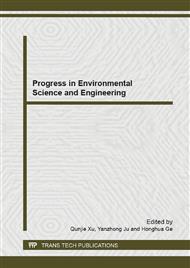[1]
K. Lee, P. Stoffyn-Egli, G.H. Tremblay, E.H. Owens, G. Sergy, C.C. Guenette, and R.C. Prince: Spill Science & Technology Bulletin Vol. 8(2003), pp.285-296,.
DOI: 10.1016/s1353-2561(03)00042-2
Google Scholar
[2]
E.H. Owens: Pure Appl. Chem. Vol. 71(1999), pp.83-93.
Google Scholar
[3]
E.H. Owens and K. Lee: Marine Pollution Bulletin Vol. 47 (2003), pp.397-405.
Google Scholar
[4]
J. Sun, and X. Zheng: J. of Environ. Monit. Vol. 11 (2009), pp.1801-1809.
Google Scholar
[5]
P.A. Wood, T. Lunel, F. Daniel, R. Swannell, K. Lee, and P. Stoffyn-Egli: in Proceedings of 21st AMOP Technical Seminar, EC, Ottawa, ON, 1: 51-77, 1998.
Google Scholar
[6]
A. Khelifa, P.S. Hill, L.O. Ajijolaiya, and K. Lee: in Proceedings of 27th AMOP Technical Seminar, EC, Ottawa, ON, 1: 383-396, 2004.
Google Scholar
[7]
A. Khelifa, P. Stoffyn-Egli, P.S. Hill, and K. Lee: Mar. Environ. Research Vol. 59 (2005), pp.235-254.
Google Scholar
[8]
J. McCourt, and L. Shier: in Proceedings of 23rd AMOP Technical Seminar, EC, Ottawa, ON, 1: 11-17, 2000.
Google Scholar
[9]
O.E. Omotoso, V.A. Munoz, and R.J. Mikula: Spill Sci. & Tech. Bull. Vol. 8 (2002), pp.45-54.
Google Scholar
[10]
P. Stoffyn-Egli, and K. Lee: Spill Sci. & Tech. Bull. Vol. 8 (2002), pp.31-44.
Google Scholar
[11]
M.C. Sterling Jr., J.S. Bonner, N.S. Ernest Andrew, C.A. Page, R.L. Autenrieth: Marine Pollution Bulletin Vol. 48 (2004), pp.533-542.
DOI: 10.1016/j.marpolbul.2003.10.005
Google Scholar
[12]
J. Sun, A. Khelifa, X. Zheng, Z. Wang, L.L. So, S. Wong, C. Yang, and B. Fieldhouse: Marine Pollution Bulletin Vol. 60 (2010), pp.1701-1707.
DOI: 10.1016/j.marpolbul.2010.06.044
Google Scholar
[13]
J. Sun, A. Khelifa, X. Zheng, Z. Wang, S. Wong, L.L. So: in Proceedings of the 33rd AMOP Technical Seminar, EC, Ottawa, 1: 145-158, 2010.
Google Scholar
[14]
L.O. Ajijolaiya: Masters Dissertation, Dalhousie University, Halifax, NS, 2004.
Google Scholar
[15]
L.O. Ajijolaiya, P.S. Hill, A. Khelifa, R.M. Islam, and K. Lee: Marine Pollution Bulletin, Vol. 52 (2006), pp.920-927.
DOI: 10.1016/j.marpolbul.2005.12.006
Google Scholar
[16]
M. Ali: Master Dissertation, Dalhousie University, Halifax, NS, 2006.
Google Scholar
[17]
A. Khelifa, P. Stoffyn-Egli, P.S. Hill, K. Lee: Spill Sci. & Tech. Bull., Vol. 8(2002), pp.19-30.
Google Scholar
[18]
J. Sun, A. Khelifa, X. Zheng, Z. Wang, S. Wong, L. So, B. Fieldhouse, and C. Yang: in Proceedings of the 32nd AMOP Technical Seminar, EC, Ottawa, 1: 109-126, 2009.
Google Scholar


